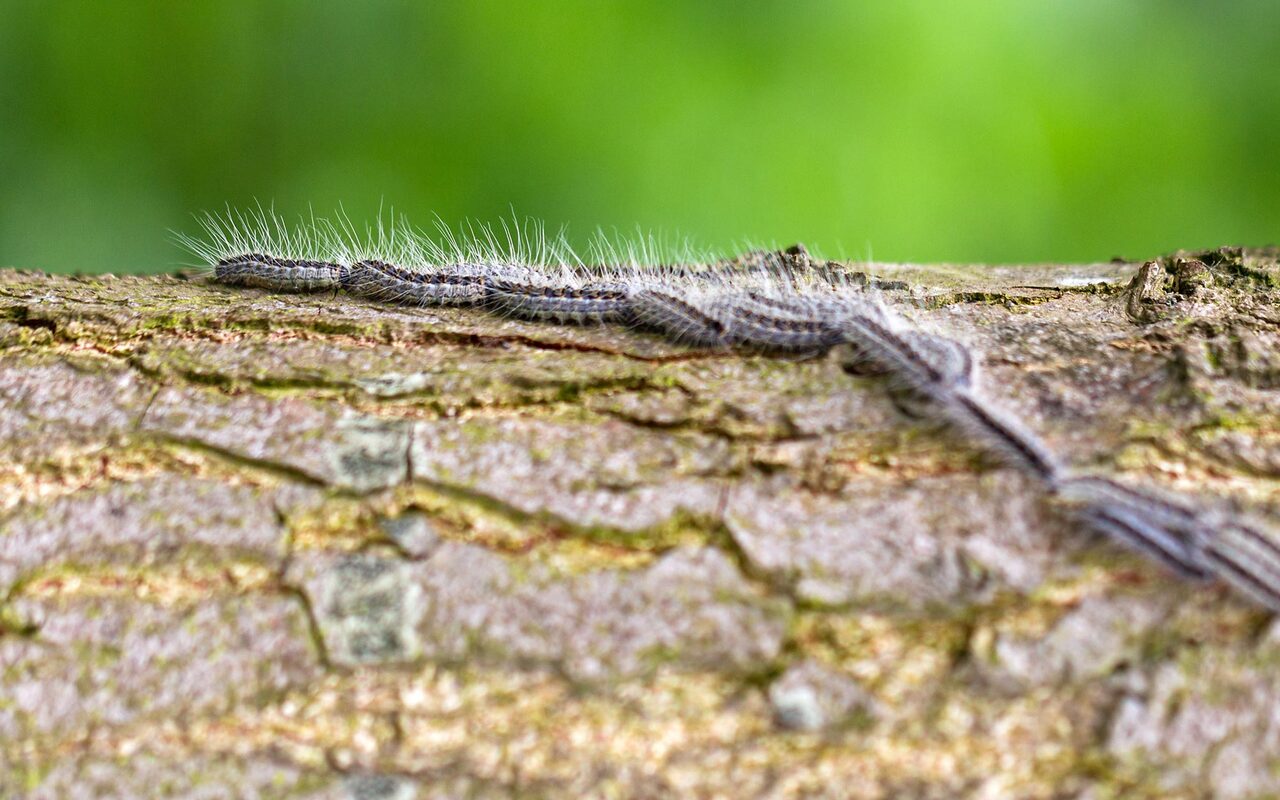Danger oak processionary moth – a hairy affair. You see them more and more often: signs on trees warning of spiders. More precisely, against oak processionary moths! For some years now, the “oak processionary moth danger” (EPS, Thaumetopoea processionea) has been on the advance throughout Europe. The caterpillar with the stinging hairs can also be found more and more often in Germany, especially in the warmer regions of Germany. Brandenburg, Berlin, North Rhine-Westphalia, Baden-Württemberg and Franconia have been struggling with the EPS since the late frosts have been steadily decreasing. But what is it about the oak processionary moth?
Table of Contents
- What is the oak processionary moth?
- The caterpillar of the oak processionary moth – the real danger
- Tree infestation oak processionary moth – whoever discovers an infested tree should do the following.
- What exactly happens when coming into contact with oak processionary moths?
- Danger oak processionary moth – is there a caterpillar dermatitis? The signs
- Contact with oak processionary moths – what now?
- Danger oak processionary moth – first aid
- Medical measures in case of contact with oak processionary moths
- What to do in case of infestation with oak processionary moths?
- Protection at work – avoiding danger
What is the oak processionary moth?
The oak processionary moth is a rather inconspicuous moth from the tooth moth family. The males reach a wingspan of about 2.5 – 3.2 cm. The females are slightly larger, with a wingspan of up to 3.6 cm. The moths prefer to lay their eggs on oaks, sometimes on other trees, such as hornbeams. These clutches consist of approximately 1 mm large, white eggs, which are often laid in the crown area and on thinner branches of old oaks – in the form of elongated plates, which are additionally camouflaged. In May, the young caterpillars hatch, having hibernated in the eggs since the fall.
The caterpillar of the oak processionary moth – the real danger.
The name of the moth comes from the fact that the caterpillars, which are harmful to the tree, move in long rows one after the other, like in a procession, when searching for food. The caterpillars go through up to six stages of development. From the third stage onwards, barbed stinging hairs appear, which contain a strong nettle venom. This venom can cause itching as well as swelling, asthma, and dermatosis. Dermatosis caused by oak processionary moths is called caterpillar dermatitis, which can also be caused by pine and pine processionary moths, as well as the golden oriole caterpillar, bear moths, and spotted moths.
Tree infestation oak processionary moth – anyone who discovers an infested tree should do the following:
- Avoid the infested area and keep away from it.
- Do not touch caterpillars or nests – keep your distance at all costs.
- Additionally, protect sensitive parts of the body
- Keep away pets (for example, dogs or horses)
- Report infested trees to local authorities
What exactly happens when coming into contact with oak processionary spiders?
Dermatitis is caused by direct contact with stinging hairs. The caterpillars lose these hairs, which actually serve as feeding protection. The hairs of the oak processionary moth then float in the air, attaching themselves to trees and undergrowth. They can also be dragged into the house in the fur of pets. Because of the barbs that the hairs have, they stick to the skin and release their venom there.
Danger oak processionary moth – is there caterpillar dermatitis? The signs:
- Skin tingling
- Conjunctivitis
- Itching, sometimes extremely strong, can last for several days
- Wheals, small red swellings
- Chills
- Dizziness
- Swelling in the throat and neck area
- Coughing
- Shortness of breath
- Asthmatic reactions
- In rare cases, allergic shock
ATTENTION: If you scratch or wipe the affected areas of the body, you can also spread the caterpillar hairs – then, in the worst case, caterpillar dermatitis can also be triggered on other parts of the body. This is called airborne contact dermatitis or aerogenous contact allergic eczema.
Contact with oak processionary moths – now what?
The non-profit European Centre for Allergy Research Foundation (ECARF) recommends the following first aid measures after contact with the oak processionary spider. Even if it is only suspected that contact may have occurred, one should take as many of these measures as possible. Health hazards to humans arise from skin contact, inhalation, or contact with the retina.
Danger oak processionary moth – First aid:
- Immediately change clothing outdoors, do not take into living quarters.
- Clean shoes
- Remove visible caterpillar hairs with an adhesive strip
- Wash clothes at least 60 degrees
- Thorough shower bath with hair cleansing
- Rinse eyes with water
- Wash, vacuum, damp clean affected objects (e.g. car)
- Bathe dogs
Danger oak processionary moth:
Skin reactions after contact with oak processionary moths?
Visit your family doctor!
Danger oak processionary moth:
Respiratory distress after contact with oak processionary moths?
Alert the rescue service immediately!
Medical measures after contact with oak processionary moths
The medical journal recommends the following measures – but these should always be coordinated with a physician:
- local symptomatic treatment with moderately to strongly effective topical corticosteroids
(externally applied creams, ointments, gels or similar, with anti-inflammatory effect)
possible in case of skin reactions - in the case of conjunctivitis (inflammation of the conjunctiva), ophthalmologic (affecting the eye) agents that also contain an antiseptic can be used
- oral antihistamines are helpful in cases of severe itching
- Beta-sympathomimetics (agents used in the treatment of asthma and chronic obstructive pulmonary disease) and/or steroid-containing metered-dose inhalers can be used for respiratory symptoms.
- Systemic corticosteroid therapy (use of cortisone) may be necessary in more severe cases.
What to do in case of infestation with oak processionary moths?
The German Federal Environment Agency also makes recommendations in the event of an infestation by oak processionary moths: Control measures against the oak processionary moth in all public areas should be taken to protect health. They are thus subject to biocide legislation. However, in the opinion of the Environmental Protection Agency, chemical or biological control measures are not appropriate in areas far from towns, villages and settlements. Approvals for use in biocidal products to control the oak processionary moth currently exist for two products.
Protection at work – avoiding danger
The press is reporting more and more frequently: schools or nurseries have to be temporarily closed due to infestations of oak processionary moths. Recreational facilities, gardens, swimming pools and parks are also often at increased risk. On private property, the respective owner is responsible for public land in the respective cities and municipalities. The German institute BAUA (German Federal Institute for Occupational Safety and Health) recommends the following measures, among others, in the event of an infestation by the caterpillars:
- Avoid staying in infested areas
- Check oaks before forestry work
- Avoid skin contact with caterpillars and nests
- Cordon off infested areas
- Signposting of dangers
- Refrain from harvesting and maintenance work as long as caterpillar nests are visible
- Have control carried out by specialists only
- Do not eat, drink or smoke in infested areas during work.
- Clean hands regularly
- Skincare according to a skin protection plan
- Immediately remove and clean personal protective equipment (PPE) properly
- Clean motor vehicles properly
- Respiratory and eye protection (at least FFP2 respirator with exhalation valve and basket goggles)
- Body-covering protective suit with headgear, e.g. chemical protective suit according to DIN EN 14605 type 4B
- Closed footwear that is easy to clean
- Control caterpillars with chemical or biological biocides, preferably between hatching and third molt.
- Suck off webs when removing them to reduce the swirling of stinging hairs.
- Refrain from wood harvesting and maintenance measures as long as caterpillar nests are visible
- Due to health risks and special working techniques, control should only be carried out by specialists.
Danger oak processionary moth? A relatively new risk that is increasingly being dealt with. A somewhat “older” topic: poisonous plants on the playground! Learn more about poisonous plants here in the eibe blog.
Picture: dennisvdw / Essentials Collection / istockphoto.com

